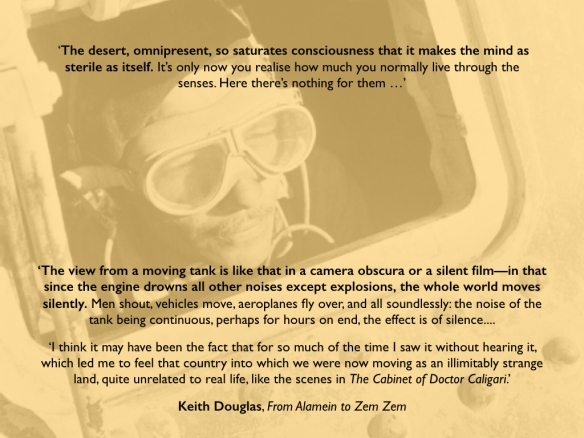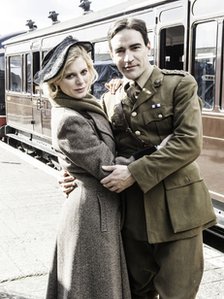 I’ve just finished reading – but certainly not thinking about – Owen Sheers‘ extraordinary dramatic poem, Pink Mist.
I’ve just finished reading – but certainly not thinking about – Owen Sheers‘ extraordinary dramatic poem, Pink Mist.
It was originally commissioned by BBC Radio 4 for its More than Words Festival in 2012 but sadly it’s not available on the BBC iPlayer Radio – though you can now get it as a physical book and an e-book.
I’ve spent much of the last several weeks reading poetry from the First and the Second World Wars, but few of those poems have affected me as much as Pink Mist. I noted Owen Sheers’ work in passing, when I was writing about Keith Douglas’s poems from the Western Desert, but Pink Mist is insistently about the present.
It tells the story of three young men – Arthur, Hads and Taff – who grew up together in Bristol, ‘playing war’ like so many other boys. They decide, a spur of the moment thing, to enlist in the British Army and soon find themselves serving together in Afghanistan:
It’s like my recruiter said today,
it’ll be a chance to do the job
they train you for.
Otherwise it’s like going to the fair,
but staying off the rides.
So yeah, I want to go to war.
But of course it’s not a fairground ride, and nobody is ‘playing war’ any more.
Sheers captures in short bursts the surreal violence of war in Afghanistan. The accidental killing of a farmer’s wife and two year old grand-daughter:
I can still see his face, even now.
An outdoor man, skin leathered by the sun,
The way he unwrapped the end of his turban
to wipe at his eyes, raw with what we’d done.
An illustrated language card issued to troops to help them communicate in Pashto and Dari, ‘a kid’s cartoon book of modern warfare’:
 Where is the pain? – Dard cheri day?
Where is the pain? – Dard cheri day?
Blood – Khoon
Dead – Maray
Go home – Khaana burayn
Shot – Wishtalay
Go home – Korta dzai
One at a time – Pa waar yao
One at a time.
And the three friends do go home, one at a time, wrapped in the shadows of violence that now fall across the lives of a mother, wife and girl-friend.
Hads returns without his legs, the victim of a ‘blue on blue’ air strike that killed two of his mates:
… that’s what you’re fighting for.
The man on your left and the man on your right.
Forget queen and country, the mission or belief.
It’s more about keeping your mates alive.
Or avenging the ones who’ve already died.
Taff is so consumed by by PTSD that he is haunted even by the silent, ‘Sunday-morning dead’ streets of his home town:
But all Taff’s feeling is the threat.
The echo of when a village went like this back there,
when the women and kids melted away.
That’s what he’s trying to keep at bay,
plugging in his headphones, turning the volume right up.
Eventually he becomes homeless, like many other vets, living on the streets:
There’s a spread of regiments under those blankets …
And a spread of wars too –
Falklands, Gulf, Northern Ireland, Iraq.
Yeah, you walk this country’ streets
and there’s our history, under your feet.
And Arthur? Read it for yourself.
It’s a profound work, I think, at once an art-work and a documentary. As in so much of Sheers’ writing, Pink Mist is based on careful research and sensitive interviewing so detailed and so intimate you can almost feel it in the sinews of the words and the cadence of the lines. Sheers records his debt to ‘the many service personnel and their families whose stories have informed this work, especially Lyndon Chatting-Walters and Daniel Shaw, whose own experiences are, at times, closely echoed in these pages.’
http://vimeo.com/35462502
 Those interviews were, in turn, part of Sheers’s research for The Two Worlds of Charlie F, a play not only about the Army’s wounded and injured from Afghanistan but also, and remarkably, largely performed by them. Sheers describes the project here (and see the clip above). In Afghanistan 22 per cent of British service personnel have been injured – a higher proportion than in the Second World War – and to prepare for the play Sheers and his director travelled the UK: ‘We became well-acquainted with the names of certain drugs, types of prosthetics, military jargon. We visited barracks, PRUs (Personnel Recovery Units) and rehabilitation centres.’ And then they worked with the soldiers. There are plans for the production to tour again this year.
Those interviews were, in turn, part of Sheers’s research for The Two Worlds of Charlie F, a play not only about the Army’s wounded and injured from Afghanistan but also, and remarkably, largely performed by them. Sheers describes the project here (and see the clip above). In Afghanistan 22 per cent of British service personnel have been injured – a higher proportion than in the Second World War – and to prepare for the play Sheers and his director travelled the UK: ‘We became well-acquainted with the names of certain drugs, types of prosthetics, military jargon. We visited barracks, PRUs (Personnel Recovery Units) and rehabilitation centres.’ And then they worked with the soldiers. There are plans for the production to tour again this year.
I’m making so much of this for two reasons beyond the power of Sheers’s project. The first is that Sheers has much to teach us about transcending the limitations of conventional academic genres and incorporating the arts into the research process, not only as objects of contemplation and critique but also as ways of working. (Think how lifeless so many ethnographies and interviews become on the printed page). The second is that Pink Mist and The Two Worlds of Charlie F ought to confound the politics of care that assumes a concern with civilian casualities is the exclusive preserve of the left, while a concern for military casualties is the exclusive preserve of the right.
As Arthur says, at the very end of Pink Mist,
So that’s all I hope for.
When the debate’s being had,
the reasons given,
that people will remember
what those three letters mean,
before starting the chant once more –
Who wants to play war?
Who wants to play war?


















